#Linen fabric breathability
Text
Explore the eco-friendly nature of linen and how it can be a more sustainable option than other materials in fashion. Whether you're a linen lover or just curious about this luxurious fabric, this blog has something for everyone.
#Linen fabric history#Characteristics of linen fabric#Types of linen fabric#Uses of linen fabric#Advantages of linen fabric#Disadvantages of linen fabric#Comparison of linen fabric with other fabrics#Sustainable fashion#Eco-friendly materials#Linen fabric care#Linen fabric properties#Linen fabric durability#Linen fabric softness#Linen fabric breathability#Linen fabric versatility
0 notes
Text
I keep seeing ads claiming viscose is this uniquely cooling and breathable wonder-fabric and its making me a bit crazy like i know ads lie i know this and yet this feels like the worlds longest unfunniest prank
Like sure i guess that viscose-elastane pajama shirt would be cooler to sleep in than a fully synthetic material but thats not exactly the claim being made
And never any mention of the other qualities of the fabric like sometimes they mention weight but never what kind of weave/knit and so on
I think it bothers me more than other marketing bullshit because i actually do run very hot and also sensory issues so im hyper aware of the feel and breathability of fabrics
#viscose is very variable with feel though im not fond of it outside of like#specific blended fibres#i think feel is a very personal thing and you kind of have to just touch a lot of fabrics#but for breathability i dont think viscose is any better than cotton or linen#and it makes more sense to me to look at the weight and construction of the fabric#i do feel a good linen trumps all though like if i had the money i would live in linens#but some of that is due to other qualities like durability and also just texture preference
3 notes
·
View notes
Text
In this blog, we delve into the world of breathable fabrics and introduce you to 8 incredible options that are designed to keep you sweat-free and comfortable, no matter the weather or activity. We discuss the unique features and benefits of each fabric, helping you make informed choices for your wardrobe. Whether you're looking for lightweight summer fabrics or moisture-wicking materials for active wear, we've got you covered. Stay cool, dry, and stylish with our selection of breathable fabrics.
#Breathable fabrics#Moisture-wicking fabrics#Lightweight breathable fabrics#Airflow fabrics#Ventilated fabrics#Cool and breathable fabrics#Sweat-wicking fabrics#Performance fabrics for breathability#Breathable fabric technology#Quick-drying fabrics#linen fabric#tencel fabric#silk fabric#bamboo fabric#cotton fabric#modal#merino#Polyester Microfiber
0 notes
Note
what should people wear in a desert? I have been stuck on this for ages 😞.
There are many tour guides on the internet that give you lists on what the best options for a trip through the desert are.
What to wear in a desert
long sleeves and long pant legs - even if it's hot, direct sunlight is never the best option, cover your shoulders and neck at all times
loose fitting clothes to allow air circulation
lightweight layers - it can get cold in the desert, so a lightweight jacket and more than one layer can come in handy
breathable fabrics - linen, cotton, merino wool
headpieces - sunstrokes are no joke, don't forget your neck
fabrics that shield you from UV light
light colours - easier with the sun, even though washing the sand out of it, is a bitch
sunglasses to shield your eyes
good walking shoes, like sneakers that are breathable, but protect your feet from the hot sand and rocks and keep you warm at night
actual hiking boots if you intend to walk around a lot
scarves to protect yourself from the sand
Other important items:
drinks
food
sunscreen
lip balms and cremes (dry desert air)
wet wipes, because everything is full of dust
(and things to save yourself of course)
And from experience, it really does get chilly as soon as the sun goes down. And the sand goes absolutely everywhere and it stains. I have a pair of shoes that is still tainted red from a trip to the desert from four years ago.
- Jana
#anon ask#what to wear in the desert#writing ideas#writing advice#writeblr#writers on tumblr#writing prompts
2K notes
·
View notes
Text
Man I wish I had more clothes made of linen
#it's such a nice fabric and it's also breathable since it's a natural fiber#only downside is that it's kind of expensive#i only own one garment that is made from 100% linen and for some reason i haven't worn it at all this summer#point is i want more linen clothes lol#lizard-dumbass talks about stuff#text post
0 notes
Note
columbo is so gender to me but i dont think i could ever look like him</3
i think it's totally possible for anyone to embody his essence. you can even manage to rock something directly inspired by columbo without looking like you're cosplaying.
hair
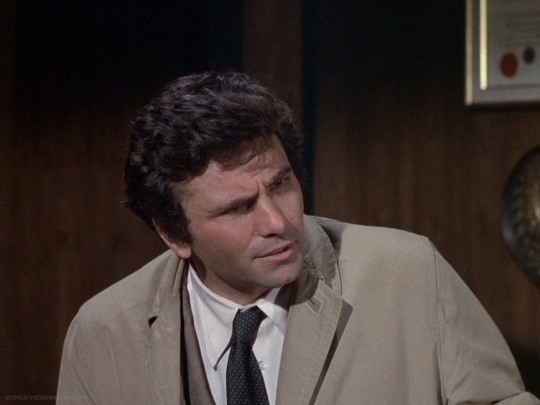



if you have columbo's hair type, it's actually pretty easy to emulate his styles. i even know people who show pictures of columbo to hair stylists to get his look. my partner's hair in its natural state is very similar to columbo's--dark, wavy, tending to grow in spite of gravity rather than with it. whenever he gets his hair cut, he shows the stylist photos of late 60s/pilot episode peter falk, whose look is actually pretty on-trend for the current era. it works out pretty well.

your swag may have aged well pilot columbo but you can't beat floof
failing that, getting any haircut that is natural, low-maintenance, and not too attention-grabbing captures the visual language all the same. for reference, natasha lyonne in poker face has her hair in natural-looking, messy waves that to me just exude columbo.

clothing
how you present yourself to the world is up to you, but if you want to invoke columbo, there's a lot more you can do than buy a tan raincoat.
in an era of sharply-cut, wide-lapelled constructions, fat tie tuesdays, and gucci loafers, columbo stands out as classic comfort personified.

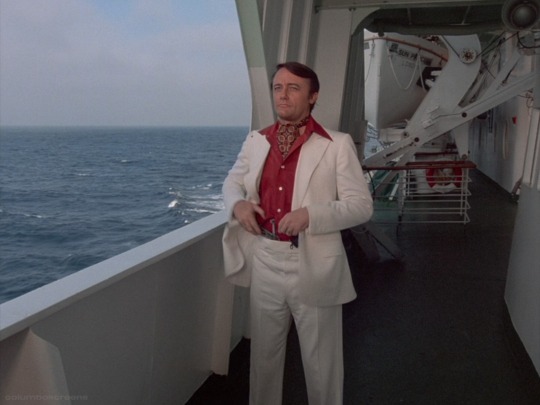


his collar, tie, and lapels are slim, proportional, and unassuming; they'd look good in almost any era. his pants fit closely to his leg but not too wide or slim, and sit at or near the natural waist. though his suits, shirts, ties, shoes, socks, and even coats rotate, there is a consistent color palette keeping him "on model". he embraces earth tones: creams, forest greens, light browns, dark browns, stony grays, rusts, and roses. his clothing seems like an afterthought, but it's an extension of his personality--rumpled and unassuming at first, yet sharp and deliberate upon further inspection.


amid the 1970s explosion of synthetic popularity, it says something that every stitch of textile on columbo's person is natural (aside from the raincoat, which is probably nylon or poly--he wears it without a lining and uses it as essentially an oversized windbreaker). his boots are leather with crepe latex soles; his tie is silk. his shirt is cotton, a bit boxy but comfortable and properly fitted. because the construction of his suits is roomy and unstructured, and because they're made of linen, they wrinkle easily.


this is easily confused for appearing slovenly. actually, all things considered, his clothes fit him pretty damn well, it's just hard to avoid wrinkling natural fibers like linen and cotton, especially in hot weather. he's running around los angeles sweating up a storm, the man needs loose, breathable fabric.

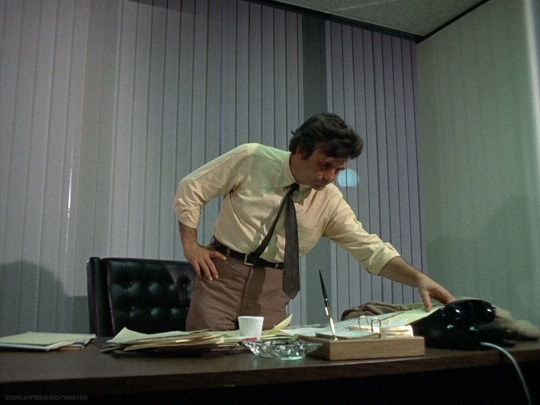
point is, columbo dresses very thoughtfully. since these clothes are workwear for him and he works a hell of a lot, it's imperative that he factors in the weather, his comfort, and proper fit when picking clothes. he wants to like and be comfortable in them while looking unassuming. so even though he sometimes ends up looking like an unmade bed, his choices are deliberate.
you could invoke these principles in your own appearance by picking earthy colors/jewel tones and comfortable, natural fabrics that you enjoy wearing, which has the added benefit of being better for you and the environment. consider also taking a few garments in to be altered. it's usually not that expensive, supports your local needlefolk, and makes even cheap clothes fit great.
as a last little aside, i think having a "signature" clothing item akin to columbo's raincoat would be a nice touch. a jacket, a pair of shoes, even a watch or necklace. something you always wear. if you really do want a raincoat like his, just make sure you're not buying a trench coat, because, repeat after me: columbo does not wear a trench coat.
#columbo#ask#misc#longpost#excuses for me to sperg about fashion#could say more about columbo's tendency to remain static while subtly following trends via hair and clothing but this post is already 2 Lon
270 notes
·
View notes
Text
hey! if you are going to the dallas or woodlands, tx show - listen up!
I don’t fault fall out boy (or their managers) for this but I can’t help but emphasize how stupid it is to book an outdoor show in texas for the end of june!! people outside of texas truly don’t understand how fucking hot it gets this time of year — and unless you experience it for yourself, you won’t get it.
temperatures right now are above 100 degrees Fahrenheit and "feel" much hotter than that due to humidity and UV index.
if you are going to the woodland or dallas show this week, please, please be careful!!!
as a lifelong texan who has endured this hellish heat for my whole life, here are some very important tips for surviving the summer weather (& not passing out):
be sure to hydrate days before the event (starting tonight!) drink mostly water, & if you have them, add those little hydration iv packets as well!
I would highly, highly recommend that you don’t drink alcohol at the event. alcohol is a diuretic and will dehydrate you!!! I would really recommend only drinking water (no diet coke, soda, or other beverages with caffeine, this is a diuretic too!)
check if your venue allows you to bring food & drink (I have heard the dos equis pavilion is allowing snacks! & outside water) & if they do — BRING THEM
eat before the show!! a full meal, not just nibbles of food. eat something rich in all major food groups: carbs, proteins and fats! (most people I have encountered pass out from a mixture of not eating & dehydration)
be conscious of your clothing — wear light colored, breathable fabric like cotton or linen (it’s going to be too fucking hot to make a fashion statement. TRUST ME!)
get to the venue later than you normally would. people in GA, I really really would advise against spending all afternoon in the sun, camping out. if you want to wait in the parking lot, do so in the comfort of your air conditioned car!! (i promise you, getting barricade at a fall out boy show is not worth passing out)
wear a hat!! & bring sunnies (sunglasses) if you are going to be outside before the sun sets
this part of texas DOES NOT cool down at night, so be prepared!!
dicks sporting goods & five below sell those cooling towels for under five bucks, please get one!!
most importantly, listen to your body!!! if you are feeling woozy, ill, lightheaded, nauseous or otherwise NOT RIGHT -- sit down, get help from staff, and get out of the heat!!!!
I’m not kidding when I say that it’s dangerous this time of year to be somewhere outdoors without air conditioning. we, texans, don’t go outside in the summer for a reason!!
#fall out boy#tourdust#i don't know how well prepared the venues are for this heat so i want YOU to be prepared!!!#im not joking when i say it gets hot enough here to melt rubber tires!!!#be safe!!! and if you feel ill -- don't tough it out!#id be happy to answer questions or provide additional information if you need it#even if you arent going to these shows please reblog this!!! the heat here is dangerous and i dont want anyone caught unaware!!#fobdallas#fobwoodlands
255 notes
·
View notes
Text
Fabric types and summer heat
The world is seeing record temperatures again. A lot of people find little comfort in their summer wardrobe these days, so it's important to be aware of how fabric types can influence your well-being in hot weather.
The following list of fabrics is by no means exhaustive, but it covers the basics.
Some of the fabrics mentioned below are expensive when bought new. You'll often find them for cheap in second-hand shops and on thrifting platforms though. I'm literally wearing a €5 linen underskirt, a €1 silk top, and a €7 silk summer dress right now, just to give an example.
General notes:
If you don't know where to start, try to stick to light-weight fabrics made of natural fibres. Look for light colours and open weaves.
You might be tempted to cover as little skin as possible in order to keep cool, but this leaves your skin vulnerable to sunburn. A thin layer of linen will often be more efficient at keeping you cool than leaving your skin bare.
Don't forget to wear sunscreen! Even if your skin type doesn't burn easily, it will still lower your chances of skin cancer. Look into sunscreens for children if you have sensory issues: they tend to be more sensory-friendly.

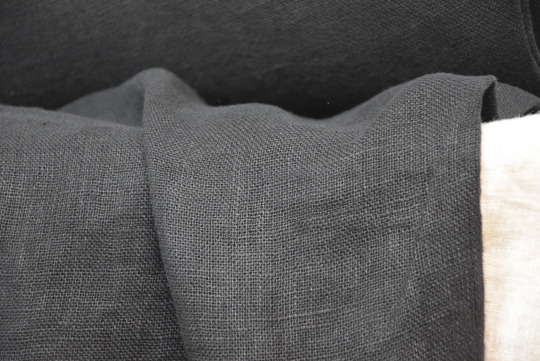
(Image source 1) [ID 1: a gray linen fabric with a tight weave.] / (Image source 2) [ID 2: a gray linen fabric with a loose weave.]
Polyester (to avoid):
Are your summer clothes making you ridiculously sweaty? Check the tag: you're probably wearing polyester.
Polyester is a synthetic fabric derived from petroleum: it's basically a plastic. It's strong, cheap, and stain resistant, which makes it a popular fabric. Even though a lot of summer clothes are made out of polyester, it's one of the worst fabrics to wear in summer.
Polyester is neither absorbent nor breathable, and captures heat. It traps sweat between your skin and your clothes, and it won't let you cool down. This leaves you feeling sticky and overheated. It can also cause static cling, which can be uncomfortable.
Not all synthetic fabrics are bad in summer: a lot of UV-blocking clothes are made of synthetics for example and can be a real life saver if you're sensitive to the sun. Try to avoid polyester if you can, though.
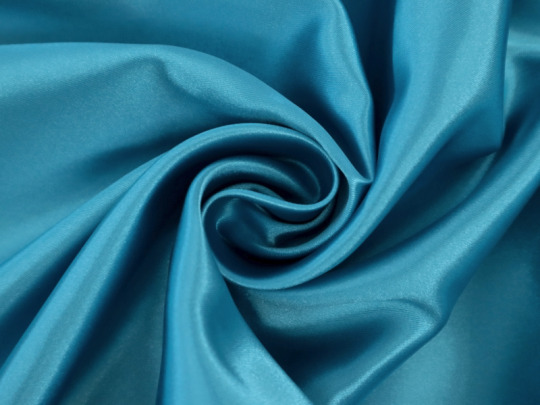
(Image source) [ID: close-up on a blue tightly woven polyester fabric that folds into a swirl at its centre.]
Cotton:
Cotton is a natural fibre that makes for a soft, durable, and breathable fabric. It allows air to circulate around your body which helps to keep you cool and get rid of sweat. It's a good basic choice.
Cotton has one downside: it's very absorbent, but takes a while to dry. If the weather's making you sweat excessively, the sweat can pool into the fabric of your cotton clothes. This will make them wet, resulting in visible sweat stains that can feel uncomfortable and will take a long time to dry.
If you can't stand how cotton feels, check out chambray weaves or bamboo textiles. They have similar properties to plain-weave cotton, but tend to be more sensory-friendly.
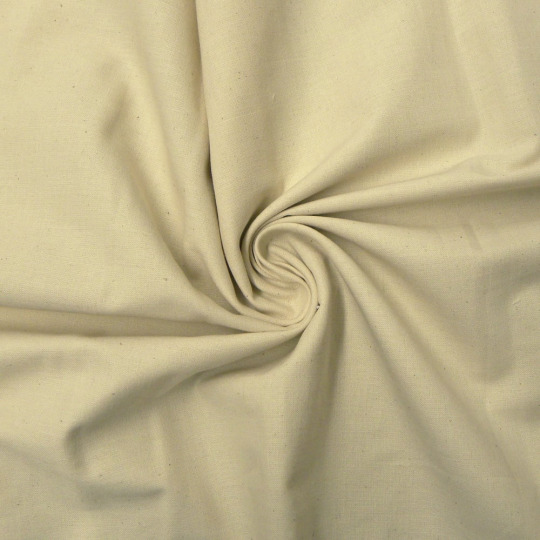
(Image source) [ID: close-up on a faded yellow tightly woven cotton fabric that folds into a swirl at its centre.]
Linen:
Linen is the absolute king of hot weather fabrics. It's strong, absorbent, dries quickly, and is very breathable. It cools you down, but won't make you feel sticky because any sweat it absorbs will evaporate fast.
I frequently layer multiple thin loose-fitting linen garments when it's hot. Loose layers allow for air to circulate between your clothes while protecting your skin from the sun. It almost functions as a wearable air-conditioner.
Note that linen is prone to wrinkling. If this bothers you, know that linen requires extra effort during laundry to avoid this.
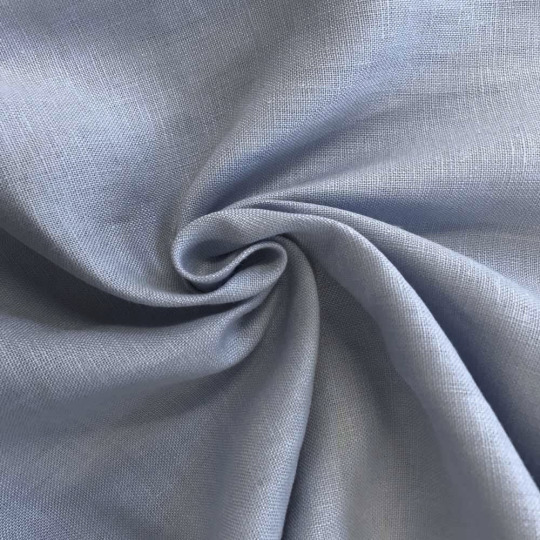
(Image source) [ID: close-up on a gray woven linen fabric that folds into a swirl at its centre.]
Silk:
Silk is yet another natural fibre that makes for a strong, quick-drying, and pretty breathable fabric. It's soft and cool to the touch, which makes it a great sensory choice.
Silk is not as breathable as cotton or linen, but dries very quickly. This means it might make you sweat more than cotton or linen does, but once the fabric's moist it will dry faster.
Note that sweat stains on silk tend to be pretty visible. Silk's also prone to static cling.
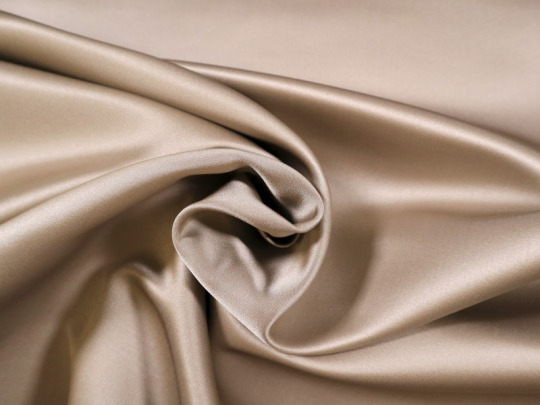
(Image source) [ID: close-up on a light brown tightly woven silk fabric that folds into a swirl at its centre.]
#wasteless crafts#fabric#summer#hot weather#sweat#fibres#silk#linen#polyester#cotton#chambray#bamboo#fabric types#fabric properties#clothes#fashion#keeping cool#heat waves#sunscreen#weather#thrifting#second hand shopping#fast fashion#slow fashion#sustainable fashion#uv blocking fabrics#tw cancer mention#tw skin cancer
2K notes
·
View notes
Note
Hello! Do you have any tips for a scent layering routine and how to always smell clean and fresh? Thank you!
Hi love! Sharing some tips below. Hope these help xx
Scent Layering Tips:
Remember your routine starts in the shower. Use fragrance-free body wash/lotion if you want to ensure they don't mix with any perfume/fragrance mists. Otherwise, test to see whether your favorite scented body wash/lotions complement each other/work together to create your desired scent.
Apply scents from the heaviest to the lightest. Apply your heady perfumes (musky, deeper, spicier, and richer-smelling scents) before your lighter fragrances (brighter floral or citrus scents). Typically, bolder perfume scents have more dynamic and/or deeper base notes (the notes that last on the skin for the longest skin [4-6 hours -once the perfume has "dried down"]. Popular base notes include vanilla, oud, musk, patchouli, sandalwood, cedarwood) and can have common heart notes [actualize around 20-60 minutes after spraying the perfume after the top notes, or initial scent, starts to fade]. Some common heart/middle perfume notes include jasmine, rose, cinnamon, geranium, lavender, black pepper, pine, and lemongrass.
When in doubt, layer two perfumes (and/or scented body products) with the same/overlapping base and/or heart notes. Think a vanilla-scented body lotion with a vanilla-based perfume or scents with vanilla-jasmine notes like Valentino Donna Born in Roma EDP layered with Versace Crystal Noir.
Don't layer two heavy scents together. Think of scents like Tom Ford Black Orchid and Mugler Alien paired together. When combined the smell can be overwhelming and give you a headache. Huda Beauty created a great fragrance scent layering guide (in the hyperlink).
How To Smell Fresh All Day Long:
Shower daily with soap and water under your arms, behind, and on the bikini area (only use water on the inside/your vulva)
Moisturize your skin daily (body hands, face)
Brush your teeth twice a day. Floss at least once a day. Keep a disposable toothbrush or at least some breath mints handy for use throughout the day if needed
Apply an antiperspirant deodorant every morning/before any activity where you think you'll be sweating. Carry around a mini one in your work bag or if you have room for one in your purse if out for several hours at a time on a hot day
Have feminine hygiene wipes and wet wipes on hand to cleanse the downstairs regions as needed
Keep some cleansing wipes/spray to refresh your body/face if you're in a hot/humid climate or are prone to sweating (I like the Pacifica Coconut Milk & Essential Oils Underarm Deodorant Wipes and Evian Facial Spray to freshen up throughout the day)
Change any liners/pads/tampons every 3-4 hours when not asleep
Wear underwear with a cotton gusset daily (lingerie is the exception)
Change your underwear and socks throughout the day
Ensure you're washing your towels and pillowcases at least once a week
Choose breathable fabrics (linen, bamboo, cotton, Tencel, silk, merino wool) in the hot/humid weather or if you're worried about sweating
Keep a rollerball of your go-to perfume to freshen up on your pulse points if needed throughout the day/night
#perfume#perfume for women#fragrance#beauty products#beauty advice#beauty tips#hygiene tips#hygiene#feminine hygiene#hygiene products#healthy habits#healthy lifestyle#skin health#girl advice#girl blogging#glow up era#glow up tips#glow up#femme fatale#dark feminine energy#dark femininity#it girl#high value woman#the feminine urge#high value mindset#female excellence#female power#queen energy#dream girl#classy life
169 notes
·
View notes
Note
do u have any hygiene tips for ppl that have physical disabilities? sometimes showering is a struggle
keep a stash of everything you need in a nightstand, potentially including:
a toothbrush (possibly electric) and safe-to-swallow toothpaste
disposable / re-fillable dental floss picks
perhaps some mouthwash tablets (n.b. I have done no research into what health claims these tend to make)
no-rinse shampoo
no-rinse body wash
a cloth and bottle of water
if you're able to make it to the shower, consider a shower chair.
if you can, wear breathable fabrics such as linen or cotton and change your clothing every day; at least try to change anything that directly touches your skin. this will keep you cleaner for longer.
if you have long hair, keep it in braids or some other protective style so that it doesn't tangle in between washings.
remember that you don't need to do everything all at once. you can wash part of your body now, and another part later; your body now and your hair later; &c.
check out this post about brushing your teeth while lying flat
another post about showering or washing while physically disabled (note that not all of these tips are feasible if you're bedbound)
172 notes
·
View notes
Text
vulcan fashion headcanons bc i have brain worms:
vulcan fashion is all about the breathable fabrics!!! i don't know if they have any animals that can produce a wool-like fabric, but i for one am all for bugs that can spin silks or fibers that act like linen. big ol' cave bugs!!! that produce silk that vulcans have traditionally collected and used to weave their fabric. bonus points if it's harmless to the bugs/environment.
while other species think vulcans must be baking in their traditional robes, their clothes are actually very lightweight and breathable.
vulcan fashion prioritizes coverage - long sleeves are traditional, as is some form of skirt or pants. head coverings are also popular amongst all genders due to the intense light of the sun.
while there are outfits for all occasions, vulcans don't usually go around in short sleeves or dresses. i like to imagine vulcans aren't a "prudish" people by any means, but there probably definitely is some logical side eye when they see someone with their epidermis out on their home world. what, do you want intense radiation burns?
while vulcan is a primarily desert world, there is a small amount of water - a little ocean. i imagine it might be a bit cooler on the shore and maybe a bit more humid? clothing there might be different than people who live in the desert based cities. more flowing fabric, an emphasis on catching the breezes that form off the ocean and while still protective, the fabric choices might aim for more sheer/lightweight texture than the desert peoples.
vulcans love beading! beading and embroidery of all kinds, especially on their formalwear. as a culture that prioritizes self control and logic, one might not think that vulcans would not be for self expression but they ARE. just like humans, they like a bit of sparkle. i imagine they're a bit more subtle in their choices, but they definitely enjoy aesthetic for it's own sake.
makeup originated as protection against the sun, but as vulcans have evolved, makeup is something all peoples enjoy. eyeliner, eyeshadows, all of it.
i imagine just as humans are drawn to the color red, vulcans are probably attuned to greens as well. maybe its a popular color, as well as cool tones in general? i can see a lot of "natural" colors being the primary choice such as sandy beiges or ochre shades, but green and blue are chosen as accents.
while many of the vulcans we see in the show have the oh so infamous bowl cut, i imagine short hair is actually quite common on vulcan. all genders rock short hair because it's easier to care for and can help keep one cool. but!! long hair is also an option, usually styled in intricate updos - lots of braids and loops of hair, lots of beautiful combs and tools used to keep long hair in place. all genders can decide to have long or short hair I DON'T CARE ABT CANON, THERE ARE MASC PRESENTING VULCANS WITH LONG HAIR TOO I WILL DIE ON THIS HILL!
while on the planet vulcans tend to adhere to their usual clothing styles, but with all of the cultural exchanges with humans and other species, they have adopted some trends. sunglasses for sure, as well as more colors and fabric types becoming popular. muslin, sheer fabrics, earth silks and brightly colored floral patterns! some of these things are considered "tacky" by older vulcans, but the younger generations love it.
102 notes
·
View notes
Note
Hi! I absolutely love your thoughts on Planetosi fashion and the culture aspects and changes in fashion over the time periods. It’s such an aspect of world building that I don’t think gets much focus in media and it gives a look into so much of a richer world that we didn’t see as much in the show (in my opinion).
I know you mentioned a bit about the Daynes style of dress, but do you have any more HCs on Dorne? I know you mentioned the the amount of layers would change according to the region because of the heat.
Yes I love thinking ab dornish fashion!!

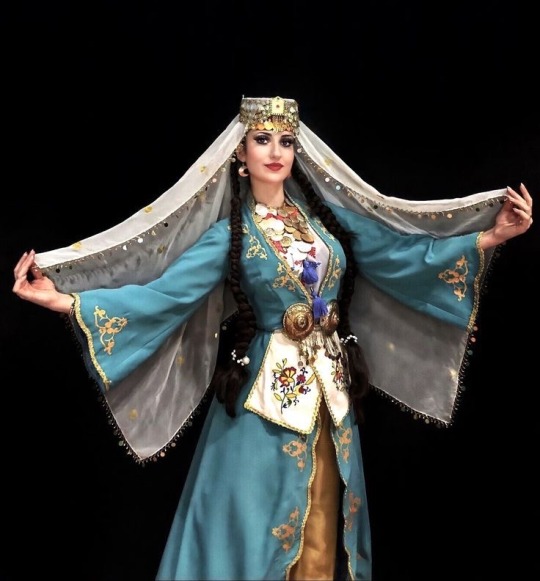
Starting from the north, near the Dornish marches and by the Red Mountains, where those with the most Andal blood live, we have a little bit of a mix between influences. Either because they live so close to the edge of the kingdom, or because Andal traditions trickled down. Clothing is thicker bc it is a (slight) bit colder for where stony dornishmen live. Textiles are also a combo of thicker fabrics they get from the stormlands/reach and traditional airy fabrics from Dorne.
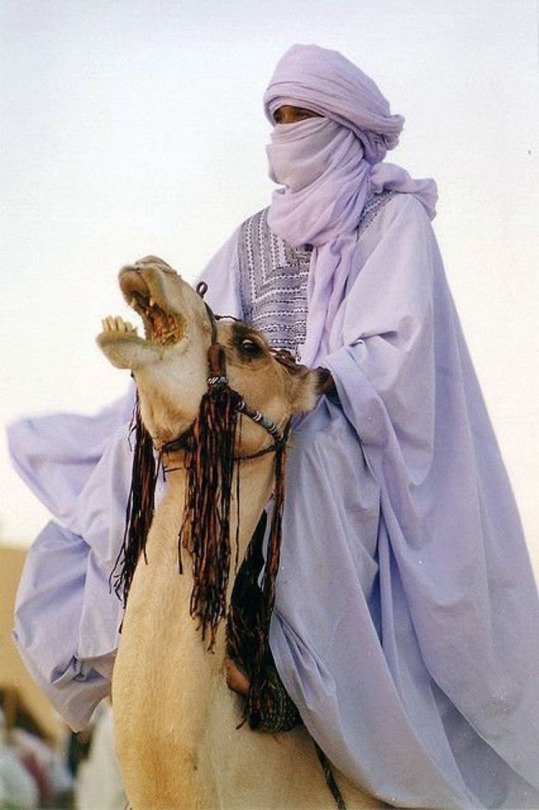
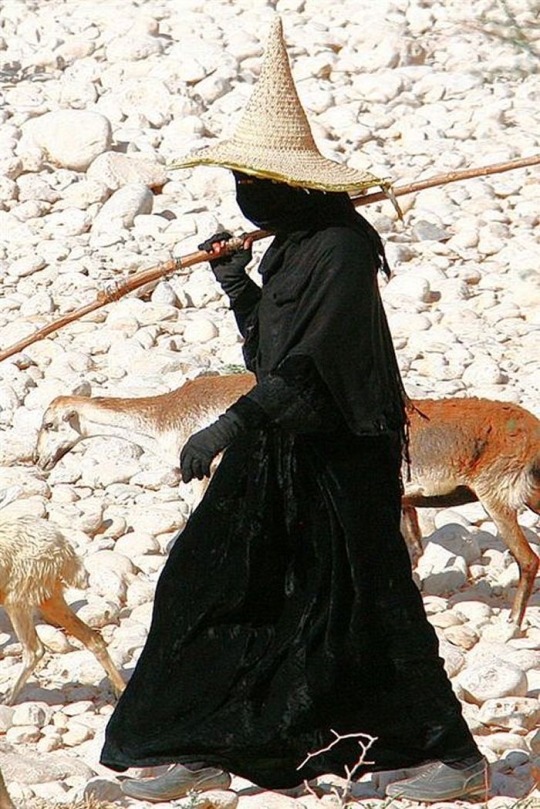
Moving to the actual deserts of Dorne, this is where you see full coverage clothing. Usually this consists of a singular long and loose shift, with added robes for added protection. If you pass a sandy dornishman in the desert, you will hardly ever see their face. Clothing is almost solely made up of cotton and linen (they’re the most breathable fabrics) and there is always going to be a turban or hat of some kind while they ride or herd or work
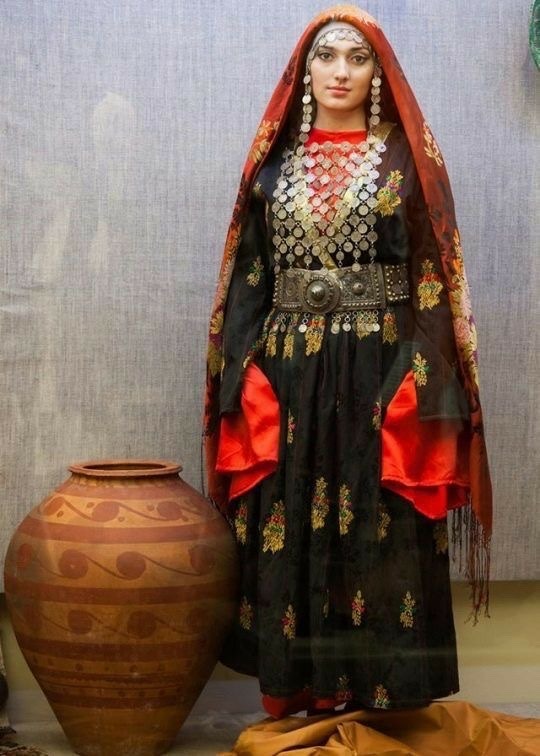

And “Salty” dornish fashion (so around the coastlines) still has strong remnants of their Rhoynar ancestors. Both in patterns/accessories and the fabrics they use. They can afford to have both light and heavy fabrics since they live near the water and weather will cool during winter, unlike the rest of Dorne. Their patterns and textiles still reflect the intricate artistry of the old Rhoynar cultures, and has striking similarities to the free cities, mostly Myr


The Martells themselves :D very much drippy. Despite the fact that Dorne is a notoriously brutal climate, their clothes reflect the fact that they are not only wealthy enough to survive but also have extravagance. I’m obsessed with the idea of gilded and embellished clothing for the Martells, especially for ceremonial/traditional clothing to show off power (the left pic is Doran and Oberyn at an important Sunspear ball is it not) ALSO I like to think that princesses of Dorne will wear their bride price on their clothing as a sort of “I’m expensive” type thing, embellishing their dresses with silver coins and charms that equal the cost of their bride price
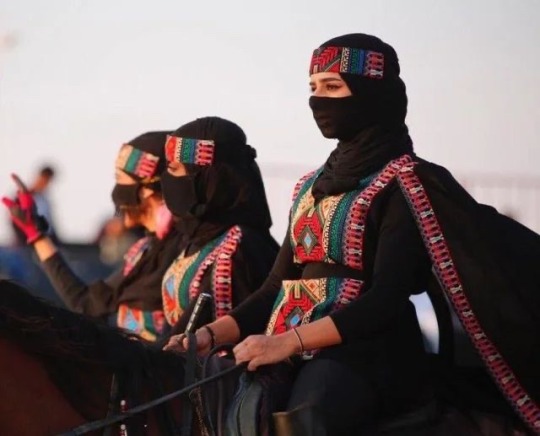

BONUS sand snake fits: I think the girlies like to match, especially when they need to go intimidate someone. Still fairly practical most of the time for riding around and fighting but still indicative of their royal blood despite their bastard status. Other times I think they fully dress practically and essentially like a commoner (when they need to stay hidden for ~espionage~ reasons) and it’s just easier to move around in whenever they’re in rough terrain. Probably favored by resident butch Obara
#asoiaf#asoiaf hair and clothing#hi :]#sorry this took so long anon 💔#I was feeling so uninspired and I still am kinda iffy ab how I feel but#we ball
277 notes
·
View notes
Text
I just queued up a post about sustainable fabrics and started to write something in the tags before realizing that it was drifting away from the point
but PSA: with the caveat that the most sustainable item of clothing is the one that's already in your closet, I would suggest that if you are someone who struggles with temperature regulation, you should seriously consider adding more linen and wool to your wardrobe. determining the "true" environmental impact of various fibers is v complicated, but for a start they both use significantly less water than conventional cotton, and imo the improvement they've had on my quality of life is well worth the substitution.
linen and wool are by far the best fabrics for temperature regulation--the former is lighter and more breathable than cotton and will keep you cooler in the summer, the latter is breathable but heavier and more insulating and will keep you warmer in the winter, even if it gets wet. (there's actually a saying among people who hike/do winter sports that "cotton kills" because you are more prone to hypothermia in cotton undergarments than in wool.) do not even get me started on linen/wool vs polyester.
this is something that I think is especially important given higher cost of heating lately, higher temperatures due to climate change, and the number of people who have health conditions or medications that make them sensitive to heat. this isn't to say that your clothing/bedding choices will compensate for a livable environment, but as someone who used to wake up 2-3 times a week sweating in synthetic sheets for four months of the year, and shiver in an inadequately heated room for another three, these little swaps can seriously make extreme temperatures a little more bearable.
that being said, wool and linen do tend to be more expensive, so if you're looking to get the most bang for your buck, I would recommend starting with:
linen sheets, even just a fitted sheet (some companies do sell them solo). overheating while sleeping is literally the worst.
linen pants, especially if you work in a job that doesn't allow you to wear shorts. linen shirts are also nice, but even cotton/poly shirts tend to be thinner than pants and might already be short-sleeved/you can roll up the sleeves, so the impact of pants will be more immediate.
a chunky wool sweater. avoid cashmere, and merino unless it has cables--these are very soft, lovely wools, but they're generally pretty light and made more for their softness than their insulation properties. for maximum warmth, you don't want a thin "office sweater," you want a "my Irish gran knit this in her cottage on the windy coast" sweater.
wool socks. these are more likely to keep you dry and warm if you're walking through slush or rain, in addition to just general walking-around-the-house warmth. for these I would say the type of wool matters a little less, generally because you do want socks that are somewhat lightweight so you can wear them in shoes. and just FYI you're also more likely to see wool socks blended with silk, nylon, or spandex for strength and elasticity, so don't drive yourself up the wall trying to find the mythical 100% wool sock. even hobby knitters tend to blend wool with something because of the amount of friction that wears on socks.
again! the most sustainable type of clothing is what you already own. but some of these are the kinds of small swaps you can definitely make over time, and you might find them genuinely helpful.
38 notes
·
View notes
Text

Out and about | September 5, 2023
Gabriela Hearst 'Nevin Cashmere and Silk Tank Top' - $490.00
As mentioned, this silk cashmere top acts as yet another textural fabric moment in this ‘fit that makes each piece pop against each other, even when existing in a relatively monochrome palette. The pointelle knit here keeps things a little more breathable, even when a pair of pants (albeit breezy ones made from linen) and heavy leather boots dominate the outfit.
Worn with: Ralph Lauren hat, Yuzefi bag, Vince pants, and The Row boots
Photo by Robert Kamau via Getty Images
129 notes
·
View notes
Text
i have gotten to the point in my buying-shit evolution to where i am disgusted, affronted, even outraged when some big name "we're so amazing and quality which is why we charge out the ass" brand wants to sell me fucking "PU leather"
it's PLASTIC. BITCH YOU THINK I'M PAYING $60+ FOR PLASTIC SHOES OR A PLASTIC JACKET OR A PLASTIC PURSE?
levis and loungefly and soooooo many others can fuck right off with that.
and DO NOT get me started on clothes and bedding being sold by prestige brands for hundreds of dollars MADE OF FUCKING POLYESTER. the gall. the temerity. the EMBARRASSMENT. the unvarnished greed of it all.
i spit on your advertisements and all your marketing writeups.
ps never fucking trust a product that the brand doesn't wanna say what it's made of. that comforter or shirt says it's "skin friendly, breathable, wrinkle free" but doesn't spell out fabric content?
bitch, it's polyester. it is made of lies and poorly recycled garbage, which is where it will soon return when it falls apart in 3-7 months.
ho, don't do it. you are worth cotton, linen, and all the other natural fibers. you deserve real leather.
108 notes
·
View notes
Note
Hello hello! I have gotten myself into an American Civil War era ball in November and I was wondering if you had any input on formal dress from the era! I've never done reenactment before but I would love some input on what I should wear!
That sounds very cool! I hope you'll have great time there when it eventually comes! :D
I'll go through all the garments and accessories that would have been used at the time, but obviously limitations of reality might get in the way of some parts. I'll give my opinion on what I think is more and less necessary to embody the era, but I've never done reenactment either so I can't really say for sure what is the expected level of historical accuracy, maybe someone with some experience of reenactment can chime in. But you'll be the best judge on what you can realistically get/make. Think of this as background info.
So the years we are looking at are 1861-65. I'll start from underlayers towards outer layers.
Shift and drawers
By 1860s drawers were used by most women with their shifts. The shift had wide neckline, small sleeves and often a bit of lace trimming. The sleeves could be wide like in the examples, but less often they might be small poofs. It was roughly knee length and still quite often made from white linen, but white cotton too.
Linen shift from mid 1800s US, and a linen shift from 1861-65.

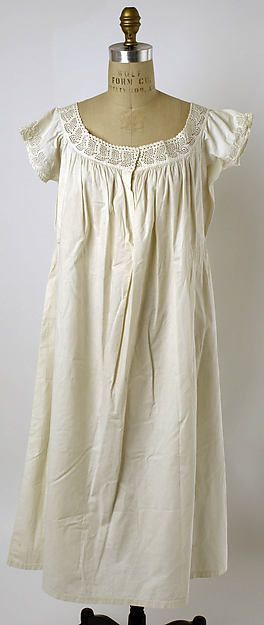
The drawers were very simple in design. They most often split crotch seam, meaning the crotch seam wasn't sewn closed and the waistband was the only thing holding the pieces together. This made it easier to use the bathroom. They reached around mid-calf, sometimes just over the knees, but ankle length was too long. 1860s drawers were very full and usually had simple lace and/or frills at the hem. They were also made from either linen or cotton at the time.
The first example is from 1863 Peterson's Magazine, where pattern for joined drawers are marketed as new, but it's still very much patterned in a way where the drawers don't need to be taken down when using bathroom. It would be still pretty rare. Then drawers from 1860s US.
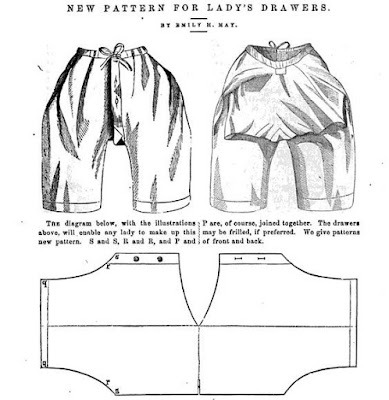

I would say basically any shift with short sleeves and wide enough neckline works here or really in place of that even almost any similarly shaped under dress, but it's very crucial to have something under the corset. If a shift isn't easily available, the replacing dress should be thin so it's not super hot, loose so it doesn't need closures that might cause chafes under the corset and preferably linen or at least cotton, so it's not sweaty and feels comfortable. Linen is really the superior undergarment material as it's anti-bacterial, very breathable and easy to wash, cotton was only contending with it for very Victorian reasons. The drawers are not necessary, not everyone used them at the time. If you don't feel comfortable not wearing any underpants (which was the other option at the time), I do recommend them since using a bathroom with the crinoline and underpants you have to take down is pretty hard.
Corset
1860s corset was fairly short compared to earlier and later corsets, and usually wouldn't reach very far on the hips. It wasn't necessary as the waistline was just above the natural waistline and the skirt was very wide so the shape of the hips would be completely covered. The corset used in formal settings like balls was usually heavily boned but for the same reasons as why the corset itself was relatively short, the bones didn't necessarily reach beyond the waistline. For these reasons even the heavily boned corsets left very large range of movement for the torso. As it was typical for the whole Victorian era, the corset was closed at the front with a busk and had lacing in the back.
The boning was usually just whalebone, metal often only used in the busk. The fabric was reinforced with most often with cotton twill or canvas. Especially in case of these fancier corsets used with evening gowns, the corset often had a silk fashion fabric, which could be white like other undergarments or colorful.
Silk corset from 1864 Britain/France, and cotton wedding corset from 1865-67 US.
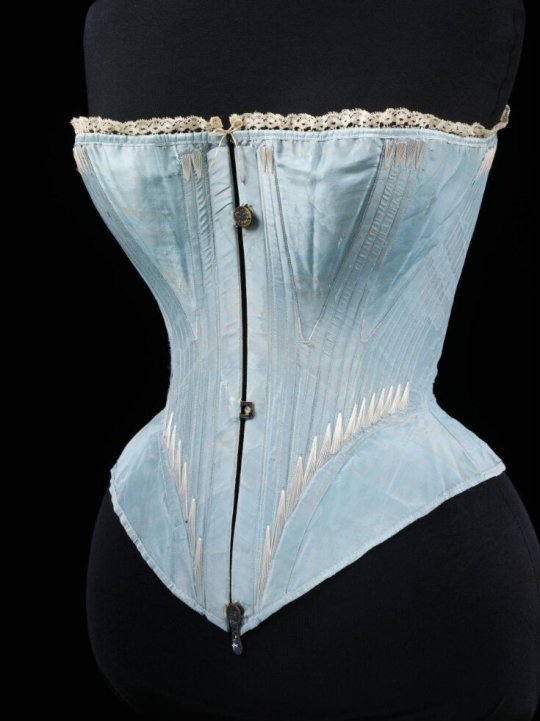
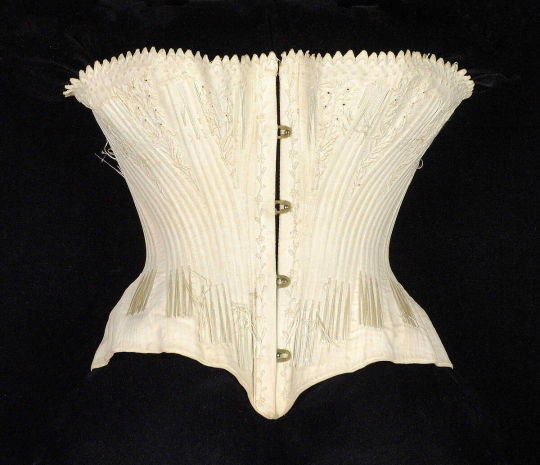
Corset really is very necessary to pull of the ball gown of this era. Not just because it's very crucial in getting the silhouette, but also because it makes it easier to wear the large skirt as the corset distributes it's weight across the torso and supports the torso too. I do think any Victorian corset works here well enough as they are roughly similarly shaped. Because the crinoline is very light, the skirt is lighter than it looks, so even other less structured supportive garments that give even somewhat similar shape could work if Victorian corsets are not an option, like Regency stays or Edwardian corsets or even some modern corset. From what I've heard about reenactment events, I would prioritize having corset (or similar) that fits you and you know you can wear for a long period of time over historical accuracy and the right silhouette. (Corset often needs to be broken in like leather shoes, because the whalebones will shape into the body.)
Crinoline
Crinoline is a crucial part of the underlayers to achieve the silhouette of this era. The silhouette went through some changes even in the first half of 1860s. It started as quite similar to late 1850s silhouette of very large and round, though already in 1861, the volume was more focused in the back. In the following years the skirt would become less round, but wider and the volume would increasingly lean to the back. The skirt would reach it's widest point with massively long back, almost like a very wide bustle, in 1865.
Crinoline from 1860-62 Spain, and another from 1865. You can see the progression quite well between these two.
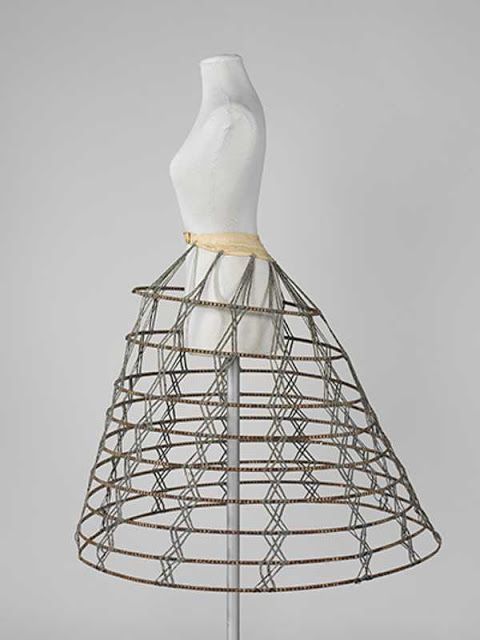

Here's also all of these foundational layers shown all at once, though I think the crinoline is from between 1866-68, since it's so narrow around the hips (the silhouette collapsed very quickly from the critical mass of 1865 to a much more narrow A-lined silhouette).

As said, this is really necessary to pull of the skirt of early half of 1860s. You really can't get the shape right without it. Especially for the earlier silhouette of the decade 1850s crinoline works perfectly fine and even the later 1860s crinoline like above. Even modern or 1950s hoop skirts can be serviceable here, but if the skirt is cut like in the mid 1860s, it definitely does need the elliptical crinoline that are very specific for those couple of years, as you'll see in the examples of the next section.
Petticoat
Petticoat's purpose in this era was mainly to smooth out the crinoline. It was therefore voluminous and usually made out of fairly stiff fabric, usually a bit heavier linen or cotton. There was often horizontal pleats around the hem, which would reinforce the shape. Couple of layers could be used too to properly cover the crinoline. It was pretty plain, usually white, but not necessarily, maybe with a bit of lace at the hem. Especially in early 1860s the petticoat was usually gathered with cartrigde pleats, which give a very round and voluminous shape. Around the mid 1860s, the pleating would be mostly focused in back to enhance the long shape.
Cotton petticoat from 1855-65 US, and linen petticoat from 1860-65 US. The first is very likely late 1855 or very early 1860s as it's so very round. The second is definitely closer to 1865, it shows very well how much more volume was at the back, as the hem there is much longer.
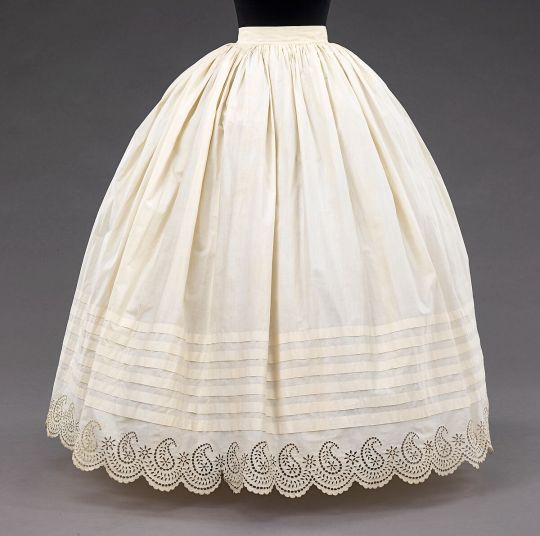

This is not strictly necessary, but it's very obvious when a crinoline doesn't have a petticoat on top of it, especially if the skirt is made out of some thinner fabric. It can be very simple, it just needs to be big enough. Basically any similar sized skirt or petticoat works fine in it's place.
Corset cover
Corset cover or camisole, as the name suggests, had similar purpose as petticoat, to smooth out the hard line of the corset. It was a small shirt, with similar neckline and sleeves as shift at the time. It was like other undergarments almost always white, often made out of cotton, but linen too.
Cotton corset cover from 1860 US, and another from 1864-68 US.
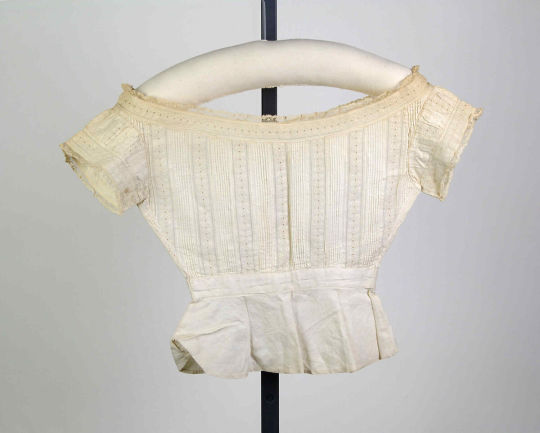
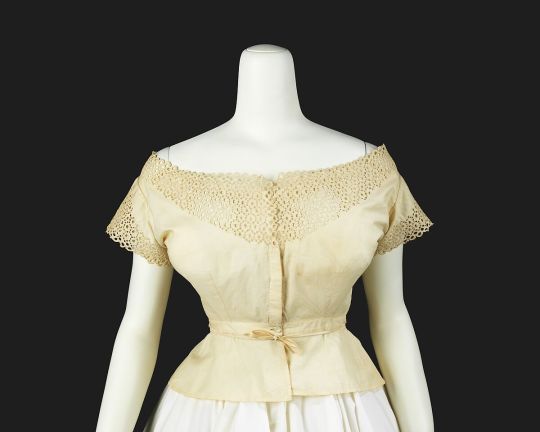
It's not super necessary imo, but it does give a smoother finish. It could be pretty easily replaced by a corset cover from different era, that's close enough in design (so it won't be showing under the bodice), if something like that is more easily available.. Any shirt really that's similarly loose-ish, so that it doesn't create too much bulk, but also doesn't get pinned tense by the bodice, would work I think.
Ball gown
Now we finally get to the meat of it. Ball gowns of the early half of 1860s had very tiny sleeves, that hung just over the shoulder. They were usually tiny poofs or could be tiny frills too. As mentioned earlier, the bodice was short and ended abruptly at the waistline, which was slightly above the natural waist, to emphasize the mass of the skirt. A typical waistline exaggerated pointed end.
The skirt was not as elaborately layered like a cake as in late 1850s, but typically it had a bit of layering at the hem, where the layers were displayed by different types of gathering. An organza layer on top was very popular. A bit of trimming at the hems of the layers of the skirt was common, but the amount of trimmings was pretty restrained (especially when compared to the next couple of decades).
The colors of evening wear were usually light. I've noticed white, light pink, light blue, mint and lavender crop up most often. It was though very trendy to have a dark or a bright jewel accent color combined with the soft dominant color. The new synthetic dyes were able to create cheep bright colors unlike before and people were very into them. The most popular colors, that were also used a lot as accent colors in evening wear were bright purple, magenta, electric blue and emerald green. The evening gowns tended to be solid color and mostly one color too, except for the accents. Typical decorative motifs were fabric flowers, bows, lace trimming and fringes. For evening wear the fabric was most often silk as taffeta or satin and possibly organza in addition.
Here's some select fashion plates with ball gowns I really like. The firs is from 1863 and the other two are from 1865.


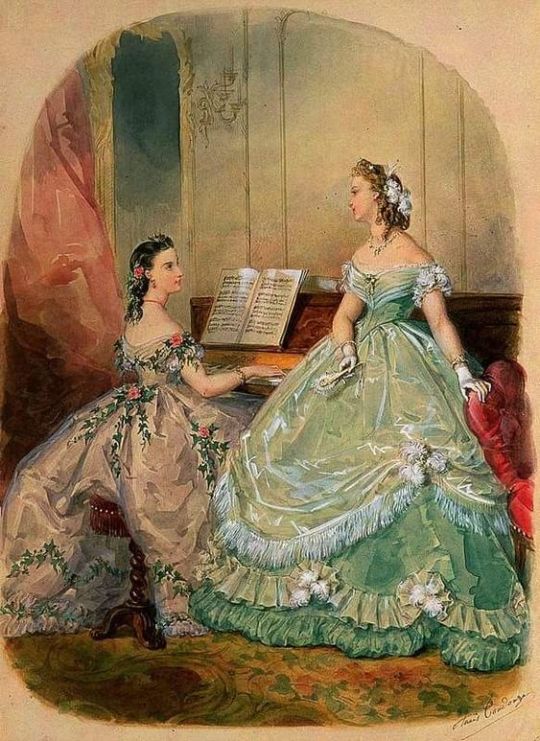
The first two include my personal favorite trend from this period, which is corselette/Swiss waist/Medici waist. It was a small decorative usually underbust waistwear, sometimes with shoulder straps, sometimes without. It was part of the Gothic Revival fashion and was alluding to Renaissance bodices and stays. They really have nothing to do with Medieval or Renaissance fashion, but Victorians associated the use of waistwear and stays as outer wear with vague idea of The Gothic for quite complicated reasons (I talk about that in this post at length). They were lightly boned, but just to keep up the shape, they were not in any way supportive, just decorative. The blue dress in the first example above has a Medici waist (the trend was loosely inspired by Catherine de Medici's portraits), which has the distinctive upward pointed neckline combined with shoulder straps, and the white dress in the second example has either Swiss waist or corselette. The terms were used quite interchangeably, even the Medici waist's definition is pretty loose (I usually just default to corselette). Below there's couple of more example of these. First is silk corselette from 1863-67 US and second is silk corselette from 1864-68 US. The third is a dress with another silk coselette supposedly from 1855 US. I think the bodice is too short for 1855 and the skirt very distinctly mid 1860s, with the volume in the back, so I won't believe MET on this. Interestingly the dress is made out of piña fabric, which is traditional fabric made out of pineapple plant fiber and was a luxury fabric among Western upper crust in 18th and 19th centuries for colonialist reasons.



Okay, I'm done with the corselette propaganda. I have a pinterest board of primary images with a section for 1860-65 for additional inspiration, but I haven't organized it yet, so there might be some misplaced images.
Accessories
These are not that necessary, but a bit of extra detail to sell the look.
Hair was kept in elaborate low buns, which could be decorated with fabric flowers and ribbons for the evening. Necklaces were pretty short and usually fairly simple. This was the time, when the iconic black silk ribbon collar became a thing. In 1860s it usually had some small (or bigger as in this royal example) pendant on it.


Gloves were strictly necessary. For evening they were always white kid (a type of thin leather) gloves, which just covered the wrists. Silk gloves were thought of as tacky. The gloves were very simple in style but bracelets were often used with them.
Above knee stockings were always used. Usually they would be white, but they did come in all kinds of colors and small patters on the ankle were common. They would be knitted silk for the evening. Here's some silk stockings in very fun colors and patterns from 1860s England. They were secured with with a wide silk ribbon tied below or above knee. I use stockings and ribbon to secure it for everyday purposes, and it works really well. The thing is to have wide enough ribbon you can circle around the leg couple of times, so it won't put too much pressure on one spot. For me below knee works the best. Really any thin knee high stockings works for this, and white is the safest bet.

There's some options with the shoes. Both boots and slippers were acceptable for evening wear and slippers could have a heel or not. The evening shoes were less practical and fancier that your day shoes. They usually had silk as the fashion fabric, which wasn't that much of an issue, since they were used indoors.
Silk evening boots from 1860s France, silk slippers with a heel from 1855-65, and silk slippers from 1862 Austria.
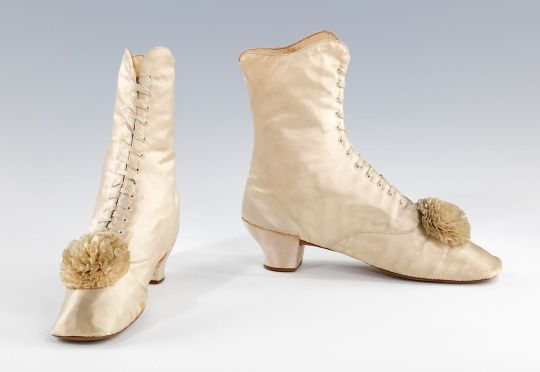
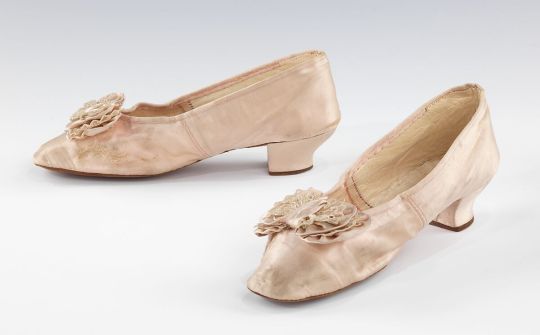
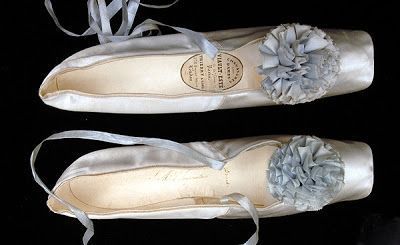
Honestly, shoes won't be really seen under the skirt, so I don't think it's very necessary to get new shoes (there are shoe sellers like American Duchess who do historical reproduction so it's possible). Basically any ballerina slippers with a somewhat flat or at least round end are pretty close. Also any shoes roughly between 1830-1880 are basically accurate (minus some details) as the shoe fashion changed pretty slowly.
I hope this was helpful for at least providing some background info!
#historical fashion#history#victorian fashion#fashion history#dress history#answers#historical costuming#extant garment#1860s fashion#fashion
124 notes
·
View notes